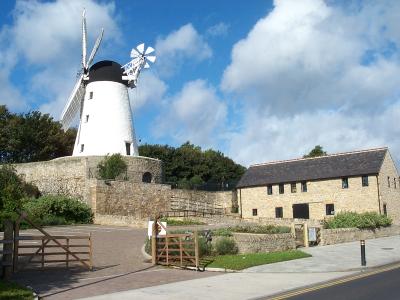Itinerary 2: Heritage Part 1
There's so much to See and Do in our fabulous city by the sea, but there's still lots more once you have finished exploring the wonderful 'riviera' coastline. From Heritage to Art we don't want you to miss out!

Suggested Start Time 9:00am
Full day Itinerary Hilights:
Roker Pier (fee applicable)
9:00am: Walk along the pier or take a tour through the pier tunnel and explore the lighthouse. Pier tunnel and lighthouse tours need to be booked in advance by visiting www.rokerpier.co.uk
Expect to spend 2 hours.
Why not try morning coffee at one of our lovely Sea front cafes? For more information click here
Fulwell Mill (Free)
A 5-minute drive, 30-minute walk or 10-minute bus ride from Roker and Seaburn Sea front expect to arrive at approximately 11:30am.
Take a guided tour around the recently refurbished Fulwell Mill and visitor centre. Note Fulwell Mill is currently closed for refurbishment, due to open early 2019. Expect to spend 1:30 hours.
Hylton Castle (Free)
A 15-minute drive or 30-minute bus journey from Fulwell Windmill, expect to arrive at approximately 2:00pm. Explore the castle site and enjoy one of the many special events taking place throughout the year. Hylton castle will be open for guided tours Spring 2019. Expect to spend 2 hours
Starting point - Roker Pier
Sunderland's landmark Roker Pier and lighthouse are Grade II listed and when opened in 1903 the structure was hailed as a true 'triumph of engineering' no mean feat in an era which saw the construction of Brunel's Clifton Suspension Bridge and Paxton's Crystal Palace.
The original lantern was gas powered, emitting a 45,000 candlepower reflected beam reputedly visible for over 15 miles out to sea. Once complete, the pier extended 2000ft (609.60m) out to sea.
The pier was the brainchild of Henry Hay Wake, chief engineer of the River Wear Commissioners. It was built using granite faced blocks, each weighing up to 45 tons, constructed on shore in an area known to this day as the blockyard.
Concrete was poured into huge wooden moulds, which were then manoeuvred into place by a vast crane called the Goliath. This was driven by gas engines, supplied by gas pipes running along a specially designed tunnel which ran the entire length of the pier.
The tunnel was later used by the keeper to reach the lighthouse in bad weather, when the waves would have been crashing over the deck and is used to this day to rescue people who become trapped on the pier in bad weather.
For more information click here
Fulwell Mill:
Fulwell Windmill started to appear on the Sunderland skyline in 1806 and became the familiar landmark we know today when opened in 1808.
Built for Joseph Swan out of magnesian limestone from the adjacent quarry, it retained its links with the Swan family for many years. 1839 saw the only recorded fatality at the mill when a journeyman miller, William Wren, was thrown from the sails during a violent storm. Regional archives show a succession of millers renting, or leasing, the mill until 1879 when the Moody family took over, operating the mill until 1949. With the advent of alternative, more reliable forms of power, windmills had to change or become obsolete.
The major change that took place at Fulwell during this time was the removal of the sails and installation of a gas engine at the beginning of the twentieth century. The mill was therefore able to carry on producing animal feed for the next half century, even though the cap that had carried the sails, and some parts of the structure of the mill, deteriorated.
After the last miller in the Moody family retired in 1949 a neighbour, Jim Simpson, from Ivy House carried on some work until 1956, on a part time basis.
Fulwell Mill has recently seen a complete restoration project and will open to the public in the near future.
There is a small café within the Fullwell Mill outbuildings which is open Wednesday - Saturday 10.00am - 3.00pm. The café is dog friendly
Built around 600 years ago, Hylton Castle stands as a magnificent reminder of the past right in the heart of the community. Much loved by local people but now standing empty, it has provided a home for barons and school boys, a stronghold for knights and a headquarters for soldiers, and tells us much about how people have lived in Sunderland for hundreds of years.
This historic site has recently been given a Heritage Lottery Fund (HLF) award to bring the 14th century Hylton Castle back into community use and is due to open in Spring 2019. To find out more or get involved click
For more information click here
Public Transport options click here:
Nearest Public toilets click here




